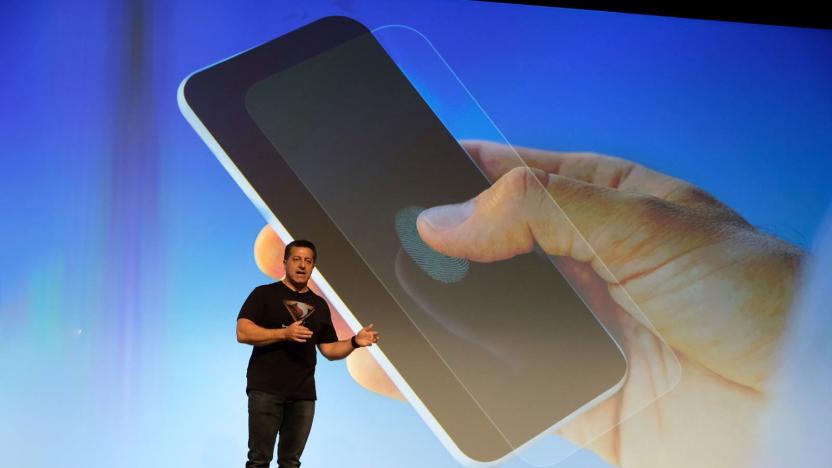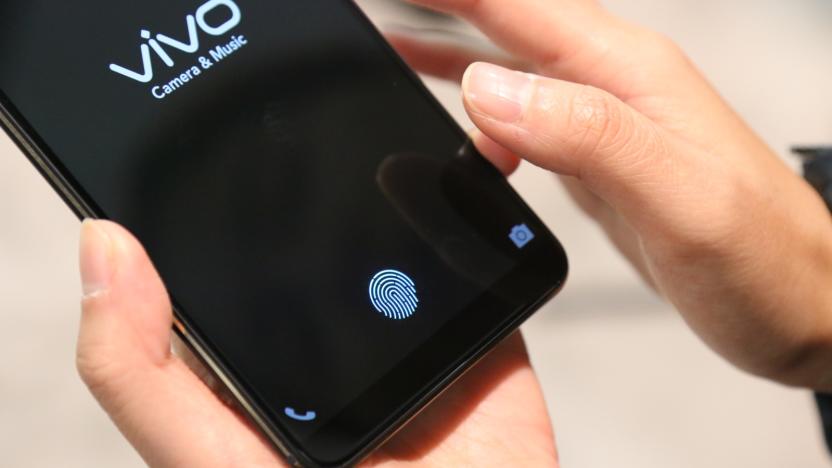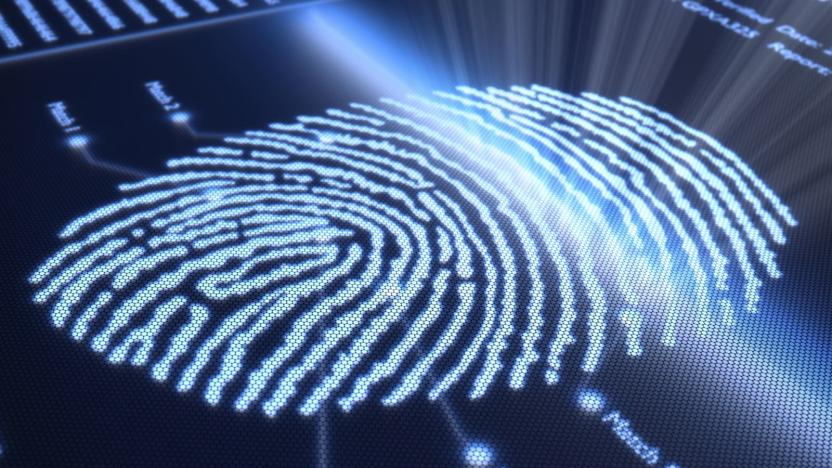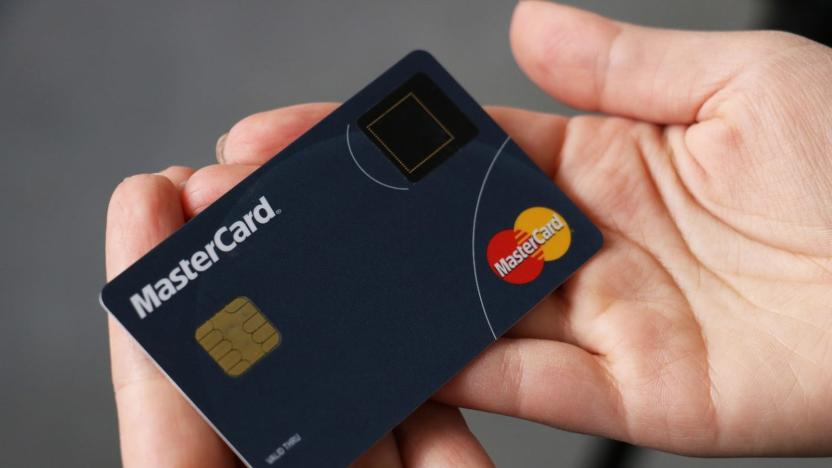fingerprintsensor
Latest

Ultrasound makes Qualcomm's new in-display fingerprint sensor super-secure
Qualcomm is being coy and not telling us everything about its new Snapdragon 855 chipset yet, but it did dig into its new ultrasonic fingerprint sensor a bit. While that might not sound like the most exciting development to come out of Hawaii this week, it has big implications for how we lock down our phones and should pop up in devices by early next year.

OnePlus 6T will include an in-display fingerprint reader
OnePlus' next phone, likely to be called the OnePlus 6T, will have an in-display fingerprint reader, CNET reports. OnePlus confirmed the feature, dubbed Screen Lock, saying it had initially planned for the fingerprint reader to be included in the OnePlus 5T, but that the technology wasn't quite ready for public release at the time. "We unlock our phones multiple times a day, and Screen Unlock reduces the number of steps to complete the action," OnePlus told CNET. "By adding this feature as an addition to other display unlocking options such as Face Unlock, users will have options to unlock the display in a way that is most efficient for them."

This phone's in-display fingerprint sensor is a taste of things to come
I just picked up a Vivo phone and laid my thumb on its screen, and voila: I unlocked it. That might not sound like much, but titans like Apple and Samsung have reportedly struggled to squeeze fingerprint sensors beneath their own displays. And yet here I am, with a prototype phone from a company most have never heard of, touching a finger to glass and watching a phone come to life.

Qualcomm's new fingerprint sensors work underwater
Hot on the heels of Apple's plans to reinvent its iPhone's fingerprint reader, Qualcomm looks set to position itself at the forefront of the fingerprint sensor market. It claims that it will be one of the first, if not the first, companies to produce under-display sensors. Unveiling its plans at Mobile World Congress Shanghai, the company revealed that its next-gen fingerprint sensors will use ultrasonic technology that can be fitted under displays, glass and metal, and can scan through OLED displays up to 1200um -- something we got to see in action for ourselves at Vivo's booth.

Mastercard adds fingerprint sensors to payment cards
Our fingerprints are quickly replacing PINs and passwords as our primary means of unlocking our phones, doors and safes. They're convenient, unique, and ultimately more secure than easily guessed or forged passwords and signatures. So it makes sense that fingerprint sensors are coming to protect our credit and debit cards. Mastercard is testing out new fingerprint sensor-enabled payment cards that, combined with the onboard chips, offer a new, convenient way to authorize your in-person transactions. Instead of signing a paper receipt or entering your PIN while struggling to cover up the number pad, you simply place your thumb on your card to prove your identity.

Synaptics' under-glass fingerprint reader is almost here
It was just a month ago when LG Innotek unveiled its under-glass fingerprint sensor, but it's clearly not the only company working on this space. At Computex, the folks over at Synaptics were kind enough to let me take a sneak peek at a similar technology that they've been working on for two years. For some reason, photography was forbidden, but the prototype was simply a special glass trackpad -- with extra details which I am not at liberty to disclose -- retrofitted into an existing laptop. It'll essentially be a spiritual successor to Synaptics' SecurePad (pictured above), but rather than having to cut a hole through the trackpad, the next-gen fingerprint sensor will simply sit underneath the glass layer, so that when it's idle, you can still use the entire trackpad area for the usual cursor and gesture controls.

Synaptics' fingerprint sensor fits inside the volume rocker
Synaptics' latest fingerprint sensor for mobile devices measures only 3.5 mm wide. It's so thin and tiny, it can fit inside a volume rocker switch on the side of your smartphone or tablet. The company is no stranger to developing sensors for various parts of the phone, such as the one it supplied for the HTC One Max that's located on the device's back plate. You might have to wait until next year to see the tiny scanner in action, though, since it's not slated to enter mass production until the third quarter of 2016. Besides the new product, Synaptics has also upgraded its SentryPoint security suite with an anti-spoofing feature.

The TappLock smart padlock opens with a fingerprint
Still fiddling with a key or combination to lock up your stuff? Get with the times, man! A company called Pishon Lab has launched a smart padlock that you can open with your fingerprint, in much the same way you unlock a smartphone. The TappLock comes in two flavors, a larger version that lasts three years and can charge up your phone, and the smaller TappLock Lite, with a six-month battery life. Thanks to iOS and Android apps, you can also unlock the device using your smartphone and store up to 100 fingerprints, letting friends use it too.

Access granted: Mobile security at the touch of a finger
Whether spurred by work regulations or the desire for personal data security, many of us spend more time than we'd like entering PIN codes and passwords to access our devices. Biometric authentication tools, specifically fingerprint sensors, can help us reclaim those moments by providing access with the touch of a finger. The technology isn't new, but it's only in the past few years that it's started to become standard on mobile devices. This week, we trace the ascent of the fingerprint sensor, from its early days as a peripheral to the embedded technology that's simplifying and securing our mobile lives.

Coming soon: laptops with fingerprint sensors built into the touchpad
At some point -- probably when the iPhone 5s came out -- fingerprint sensors became cool. Yes, they've been used on business laptops for years, but it's only recently that we've started to see them in stuff consumers would buy -- things like smartphones and tablets. Now, it seems, we're coming full circle. Synaptics, the leading maker of laptop trackpads, just announced something called the SecurePad, a touchpad with a fingerprint sensor built into the upper-left corner. Unlike existing fingerprint scanners for laptops, which require users to swipe their fingers over the sensor, this one uses capacitive touch, similar to the fingerprint modules used in devices like the iPad mini 3 and Galaxy S5. The result should hopefully be a more reliable experience than you would have gotten on older-gen laptops, but as we've seen with newer products, even touch-based fingerprint scanners can be a mixed bag.

New MasterCard combines a fingerprint sensor with NFC
For awhile now, there's been a number of companies trying to simplify payments for everyone. Google did so with Wallet and, most recently, Apple announced it would be doing something similar with the soon-to-be-launched Apple Pay, among others. Not surprisingly, MasterCard's, synonymous with paying for stuff, is working on a product of its own. In partnership with Zwipe, a company that focuses on biometric tech, MasterCard has built a charge plate with a built-in fingerprint sensor and NFC, albeit for trial purposes. The Zwipe MasterCard, as it is currently known, is said to be extremely secure -- all data is stored directly on the card, rather than an outside database, for example.

Oh look, another "easy" way to spoof Touch ID on the iPhone 5s
I'll be honest: I'm getting kind of tired of seeing words like "easy" and "simple" being used to describe the ridiculous how-to videos showing that it's possible to trick the Touch ID sensor on the iPhone 5s into believing you're someone you're not. The latest in what is sure to be a never-ending string of "me too!" hackers claiming they have figured out the best way to fool the iPhone is SRLabs, though I'm not seeing how this could possibly be categorized as "easy." Here's a list of the steps to pulling off this spoof (you can check out the process used by the Chaos Computer Club on our original article regarding the trick). First, snap a photo of a perfect print from the finger that will unlock the device. Without the victim knowing, of course. Use digital photo software to separate the print from the rest of the image and then "retouch as required." If your spouse or nosy friend has recently been taking Photoshop classes, this might be why. Print the image of the fingerprint on translucent plastic using black toner. Place the image of the print over a piece of photo-sensitive copper circuit board and then expose it to intense UV lighting. The folks from SRLabs used a face tanner for this. You have one or two of those laying around, right? Develop the circuit board in a bath of Sodium Carbonate Monohydrate or Potassium Carbonate. You know, just whichever one you have in the pantry. Etch the fingerprint into the copper by placing the copper board into an etching solution. Cover the print mold with graphite spray to help spoof the capacitive properties of a normal human finger. Cover the print in wood glue, let it dry, and then peel it from the mold. Oh, and the most important step of them all: Steal the phone from the victim, without them knowing it. If they find that their phone has been stolen, they can remotely wipe the device, which would mean you just did a lot of hard work for nothing. Then unlock the device. You only have a few attempts to do this correctly, because if you fail multiple times in a row the device will demand the numeric passcode and your plan is foiled. Easy! Right? RIGHT!? Seriously though, every time one of these groups comes forward with another slightly tweaked method for fooling Apple's top-of-the-line smartphone, I can't help but think how much easier it would be to just steal the phone in broad daylight and then torture the owner into unlock it themselves. If there's anything on your phone that would warrant someone to go through these insane steps to breach its security features, you should probably be using a 20-digit passcode and keep your phone within your grasp at all times. Touch ID isn't infallible, but it's better than a 4-digit passcode (which can be brute-forced in less than an hour or simply spied by someone peeking over your shoulder), and it's clearly better than no security at all, which is how many consumers use their phones every day.

Apple reveals Touch ID, a fingerprint sensor built into the iPhone 5s
In a move sure to delight security and privacy gurus, Apple revealed today at its iPhone event that the all-new iPhone 5s features a fingerprint sensor built into the home button. The technology is built into a ring around the home button that can scan sub-epidermal layers of your skin in order to identify you without the need to a passcode or other more archaic security measures. But beyond just allowing you to access your phone, Touch ID can be used to verify things like iTunes purchases without a password. Apple claims that the process of setting it up is super simple, and given the fact that it is a biometric sensor, it's certainly more secure than your mother's maiden name. To further please security advocates, Apple confirmed that the data is never stored on Apple's servers or backed up in the cloud -- it's all saved only to the device in your hand.

Alleged iPhone 5S render shows new home button / 'Touch ID sensor'
We're just a few hours away from Apple's big iPhone press conference, and Nowhereelse.fr has just posted this render (from a "very reliable" source) that claims to show the iPhone 5S. The most notable change shown is of course, the home button, seemingly minus the usual squarish target and called the "Touch ID sensor". That is expected, considering repeated rumors (check out our roundup) including an apparent confirmation tonight from the Wall Street Journal, that Apple's next flagship phone will include a fingerprint sensor. Whatever the truth is, it will be unveiled at 1PM ET, and we'll be there liveblogging every minute. Update: Yes, that's it! Check out all of the official info on the iPhone 5s and its Touch ID fingerprint authentication system right here.

iOS 7 beta 4 hints at upcoming iPhone fingerprint sensor
Ever since Apple's purchase of biometric sensor company AuthenTec last year the rumor mill has been abuzz with predictions that a future iteration of the iPhone would employ built-in fingerprint authorization. Now, as 9to5Mac reports, Twitter user Hamza Sood has discovered a folder in the newly released iOS 7 beta 4 that references a biometric user interface, complete with descriptions of a setup process that includes images of a color-changing fingerprint and a person holding an iPhone with their thumb on the Home button. Earlier this month Apple was granted a patent for an in-display fingerprint sensor which would allow for biometric functionality while negating the need for a separate sensor panel. This new evidence certainly isn't a confirmation of such a feature being included in the next iPhone -- rumored to be called the iPhone 5S -- but it's definitely more validation than we normally see regarding rumors of this magnitude. [Image credit: Hamza Sood]

Apple files patent application for fingerprint sensor that can be transparent or opaque
While Apple has flirted with biometric-based patents before, we've yet to see them implemented in real-world technology. That hasn't stopped it from filing yet another one though, as the latest application reveals a fingerprint sensor apparently embedded into the iPhone itself. The patent describes a hardware "window" that can become selectively "transparent or opaque." When transparent, it would reveal a component comprised of an "image capture device, a strobe flash, a biometric sensor, a light sensor, a proximity sensor, or a solar panel, or a combination thereof" as a method of unlocking the phone. According to the filing, the biometric sensor in question might indeed be a fingerprint reader. The document goes on to describe an alternative method using face or eye recognition technology that can be used not just for security purposes, but for possible e-commerce solutions like completing an online transaction. Of course, take any of these patent applications with a generous pinch of salt -- we haven't seen an Apple stylus yet, for example -- but perhaps this is the reason Apple bought fingerprint sensor maker AuthenTec back in July.

Microsoft patent details pressure-sensitive Xbox controller for storing players' profiles
Biometrics and laptop security go together like business meetings and boardrooms, but this Microsoft patent hints that gaming could be the next frontier for fingerprint recognition. The claims for "personalization using a hand-pressure signature" detail a product that may look like your standard 360 controller, but it features sensors to detect a user's identity. It seems that, based on each gamer's unique hand pressure patterns, the controller can determine who is holding the device at any given moment and deliver personalized content based on that user's gaming profile. Whatever Microsoft's mystery controller may be, E3 is just a few weeks away, so perhaps we'll learn more then.

Apple patent filing details "touch and go" USB devices
digg_url = 'http://digg.com/apple/Apple_patent_filing_details_touch_and_go_USB_devices'; We already caught sight of a whole batch of Apple patent applications earlier this month, but it looks like the company still has a few more big ideas up its sleeve, which may or may not actually come to fruition. The most interesting of those is what's described as a "Portable Device Capable of Initiating Disengagement from Host System," or a "touch and go" system as AppleInsider calls it. That, as you may be able to discern, is essentially a touch sensor tied to a USB drive or other USB device, which would be able to sense when you touch it (or even when you're about to touch it, apparently), and then disconnect the device from the computer before you're able to cause any data corruption. Better still, the system could apparently also double as a fingerprint sensor in some implementations, and completely lock down the device if an unauthorized user grabs it.[Via AppleInsider]

Seiko Epson developing tiny fingerprint sensor
With all this paranoia surrounding identity theft, we've seen fingerprint sensors on everything from hard drives to door locks to laptops, but the common feature on all of those is the relative thickness of the device. By "relatively thick," we mean that these current tags would probably bulk up your wallet in a bad way should they ever be used to tag things like credit and debit cards. Seiko Epson is on top of it, however, and are developing a ridiculously thin (0.2mm) fingerprint sensor that will allow mobile devices to be easily secured by biometrics. Potential applications, aside from deterring thieves from swiping your self-authenticating credit card, are tagging cellphones, MP3 players, and essentially anything that can fit into your pocket. The sensor operates by reading the faint electric current that emanates from your fingertip and conveys your specific print pattern for verification -- if it detects somebody trying their best to mimic your phalanges, it deactivates the device, rendering it useless to the perpetrator. While there's a certain sense of security gained by having everything you own equipped with a fingerprint sensor, we can envision that sharing your tagged gadgetry with friends could become tricky, and while Seiko Epson can't quite put a finger on a release date, it's expecting 2010 before this goes full scale.[Via Pink Tentacle]















